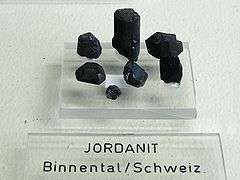Jordanite
| Jordanite | |
|---|---|
|
Jordanite from Binnental, Switzerland | |
| General | |
| Category | Sulfosalt minerals |
| Formula (repeating unit) | Pb14(As,Sb)6S23 |
| Strunz classification | 2.JB.30a |
| Crystal system | Monoclinic |
| Crystal class |
Prismatic (2/m) H-M symbol: (2/m) |
| Space group | P21/m |
| Identification | |
| Colour | Lead-grey |
| Cleavage | Perfect |
| Fracture | Conchoidal |
| Tenacity | Brittle |
| Mohs scale hardness | 3 |
| Lustre | Metallic |
| Streak | Black |
| Density | 6.4 |
| Pleochroism | Visible |
Jordanite is a sulfosalt mineral with chemical formula Pb14(As,Sb)6S23 in the monoclinic crystal system,[1] named after the German scientist Dr H. Jordan (1808–1887) who discovered it in 1864.
Lead-grey in colour (frequently displaying an iridescent tarnish), its streak is black and its lustre is metallic. Jordanite has a hardness of 3 on Mohs scale, has a density of approximately 6.4, and a conchoidal fracture.[1]
The type locality is the Lengenbach Quarry in the Binn Valley, Wallis, Switzerland.[1]
References
| Wikimedia Commons has media related to Jordanite. |
This article is issued from Wikipedia - version of the 10/15/2016. The text is available under the Creative Commons Attribution/Share Alike but additional terms may apply for the media files.
